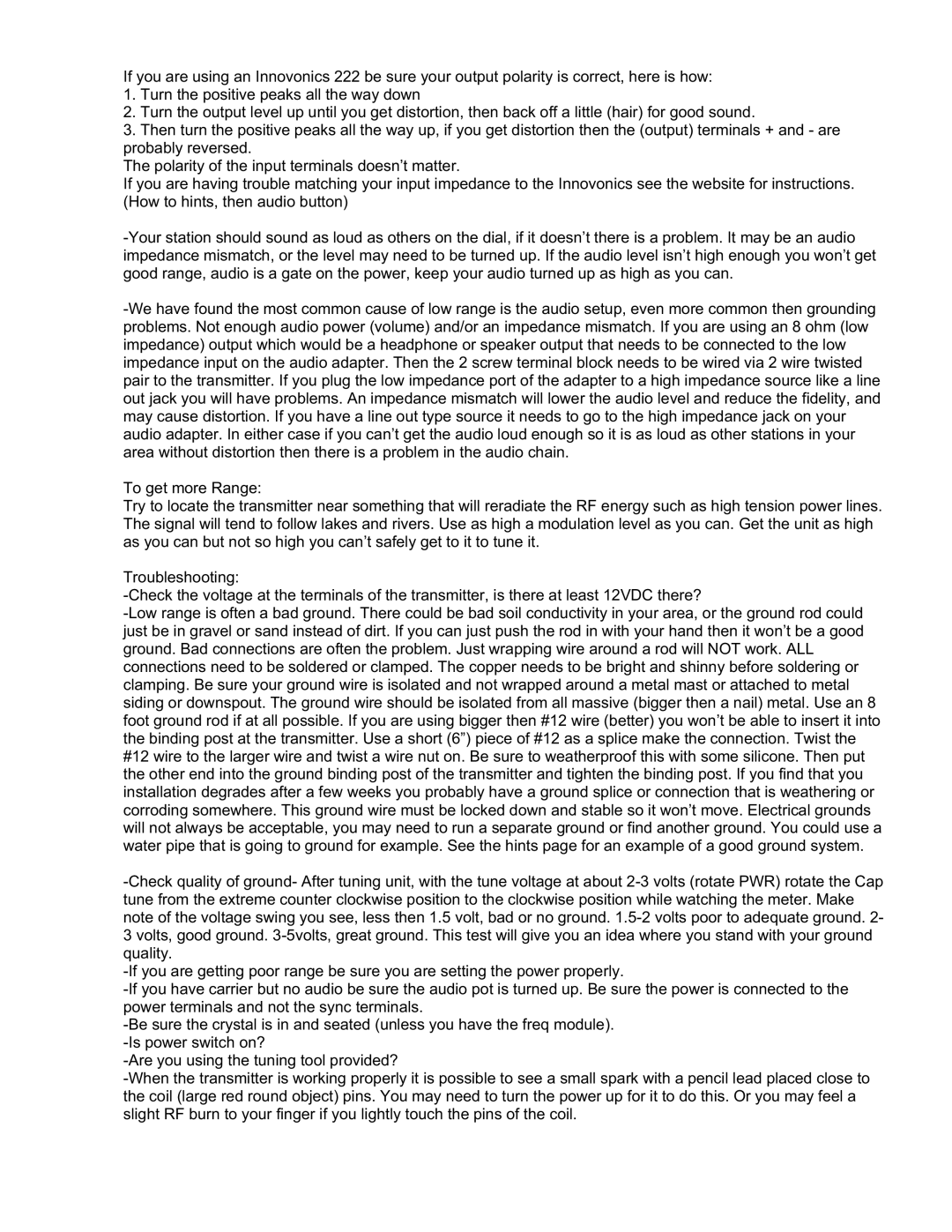If you are using an Innovonics 222 be sure your output polarity is correct, here is how:
1.Turn the positive peaks all the way down
2.Turn the output level up until you get distortion, then back off a little (hair) for good sound.
3.Then turn the positive peaks all the way up, if you get distortion then the (output) terminals + and - are probably reversed.
The polarity of the input terminals doesn’t matter.
If you are having trouble matching your input impedance to the Innovonics see the website for instructions. (How to hints, then audio button)
-Your station should sound as loud as others on the dial, if it doesn’t there is a problem. It may be an audio impedance mismatch, or the level may need to be turned up. If the audio level isn’t high enough you won’t get good range, audio is a gate on the power, keep your audio turned up as high as you can.
-We have found the most common cause of low range is the audio setup, even more common then grounding problems. Not enough audio power (volume) and/or an impedance mismatch. If you are using an 8 ohm (low impedance) output which would be a headphone or speaker output that needs to be connected to the low impedance input on the audio adapter. Then the 2 screw terminal block needs to be wired via 2 wire twisted pair to the transmitter. If you plug the low impedance port of the adapter to a high impedance source like a line out jack you will have problems. An impedance mismatch will lower the audio level and reduce the fidelity, and may cause distortion. If you have a line out type source it needs to go to the high impedance jack on your audio adapter. In either case if you can’t get the audio loud enough so it is as loud as other stations in your area without distortion then there is a problem in the audio chain.
To get more Range:
Try to locate the transmitter near something that will reradiate the RF energy such as high tension power lines. The signal will tend to follow lakes and rivers. Use as high a modulation level as you can. Get the unit as high as you can but not so high you can’t safely get to it to tune it.
Troubleshooting:
-Check the voltage at the terminals of the transmitter, is there at least 12VDC there?
-Low range is often a bad ground. There could be bad soil conductivity in your area, or the ground rod could just be in gravel or sand instead of dirt. If you can just push the rod in with your hand then it won’t be a good ground. Bad connections are often the problem. Just wrapping wire around a rod will NOT work. ALL connections need to be soldered or clamped. The copper needs to be bright and shinny before soldering or clamping. Be sure your ground wire is isolated and not wrapped around a metal mast or attached to metal siding or downspout. The ground wire should be isolated from all massive (bigger then a nail) metal. Use an 8 foot ground rod if at all possible. If you are using bigger then #12 wire (better) you won’t be able to insert it into the binding post at the transmitter. Use a short (6”) piece of #12 as a splice make the connection. Twist the #12 wire to the larger wire and twist a wire nut on. Be sure to weatherproof this with some silicone. Then put the other end into the ground binding post of the transmitter and tighten the binding post. If you find that you installation degrades after a few weeks you probably have a ground splice or connection that is weathering or corroding somewhere. This ground wire must be locked down and stable so it won’t move. Electrical grounds will not always be acceptable, you may need to run a separate ground or find another ground. You could use a water pipe that is going to ground for example. See the hints page for an example of a good ground system.
-Check quality of ground- After tuning unit, with the tune voltage at about 2-3 volts (rotate PWR) rotate the Cap tune from the extreme counter clockwise position to the clockwise position while watching the meter. Make note of the voltage swing you see, less then 1.5 volt, bad or no ground. 1.5-2 volts poor to adequate ground. 2- 3 volts, good ground. 3-5volts, great ground. This test will give you an idea where you stand with your ground quality.
-If you are getting poor range be sure you are setting the power properly.
-If you have carrier but no audio be sure the audio pot is turned up. Be sure the power is connected to the power terminals and not the sync terminals.
-Be sure the crystal is in and seated (unless you have the freq module). -Is power switch on?
-Are you using the tuning tool provided?
-When the transmitter is working properly it is possible to see a small spark with a pencil lead placed close to the coil (large red round object) pins. You may need to turn the power up for it to do this. Or you may feel a slight RF burn to your finger if you lightly touch the pins of the coil.
